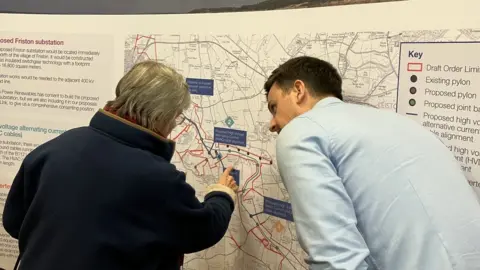Consultation on Suffolk-Kent Sea Link project ends after 1k responses
 Guy Campbell/BBC
Guy Campbell/BBCAn eight-week public consultation on an offshore electricity project has ended with more than 1,000 people responding.
The National Grid's Sea Link would see a 90-mile (145km) underwater cable between Suffolk and Kent.
The plans also included onshore sub-stations and converter stations, which opponents said would run through a nature reserve at Aldeburgh in Suffolk.
Project director Adrian Pierssene said the work was "essential in the UK's journey to net zero by 2050".
 Guy Campbell/BBC
Guy Campbell/BBCFollowing the public consultation, National Grid was expected to submit its proposals to the Planning Inspectorate next year as a Nationally Significant Infrastructure Project.
The proposed cable would carry windfarm and nuclear-generated electricity from the Aldeburgh/Thorpeness area to the Kent coast between Sandwich and Ramsgate in Kent.
As part of the project, sub-stations would be built in Friston, Suffolk and Richborough, Kent, as well as converter stations near Saxmundham, Suffolk and Minster near Ramsgate.
National Grid said it was pleased to see so many members of the public take part in the consultation, which it said gave local communities an opportunity to see how the plans had developed and to provide further feedback on the proposals, before it submitted its planning application.
"[It] is part of a wider programme to upgrade the entire network," Mr Pierssene continued.
"We have heard from more than 1,000 residents and stakeholders during this statutory consultation - we want to thank everyone who has taken the time to comment on our plans."
 Guy Campbell/BBC
Guy Campbell/BBCThe project would see underground cables run through RSPB North Warren Reserve at Aldeburgh, which campaign group Suffolk Energy Action Solutions (SEAS) called "destructive".
David McKenna, from SEAS, said: "Our publicity campaign has been really ramped up as these destructive projects come to each community. They then realise what the impacts are likely to be and we are getting a lot of new members.
"I think the problem is over a number of decades the government has effectively surrendered control of this industry to the private sector, so it has very little influence now on what gets done."
National Grid said the cables would be installed by "trenchless underground construction methods" which would allow them to "safely install cables whilst minimising interaction with the land surface - thereby reducing the impact on wildlife, traffic and local communities".

Follow East of England news on Facebook, Instagram and Twitter. Got a story? Email [email protected] or WhatsApp 0800 169 1830
